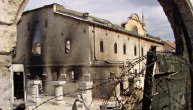Serbs from Kosovo and Metohija on March 17: Fire and chaos. My father and pregnant woman were killed
All the houses in the street, 28 of them, were set on fire. KFOR and the police pulled us out of our homes and transported us to a neighboring Serb village," Zoran Simijonoviv from Lipljan recalled the events of March 17, 2004
"We were attacked by about 2,000 people. They were setting fire to houses, shooting, a bomb was thrown at our house and we remained trapped," Zoran Simijonovic from Lipljan recalled today, telling Kosovo Online what it was like like on March 17, 2004, when a pogrom of the Serb population in Kosovo and Metohija took place.
"All the houses in the street, 28 of them, were set on fire. KFOR and the police pulled us out of our homes and transported us to a neighboring Serb village. Three of my houses, machines and a production plant were burned down," he said.
The March Pogrom was the trigger for the expulsion of the remaining Serb families from this city.
"At that time, we had about 3,000 Serbs in Lipjan. In two days, 1,500 Serbs left the city and never returned. Some of their homes were renovated, but soon after that they sold their property and left forever," Jovica Miric, president of the Serb community in Lipljan, told Kosovo Online.
One Serb was killed during the riots and violence in Lipjan, and those who managed to save their lives say they cannot forget the horror they survived. Still, they hope to remain.
"There are about 700 of us in Lipljan. Many young people have graduated from school. About 20 jobs are necessary for those young people in order for the Serb community in Lipljan to remain and survive," says Zoran Simijonovic.
Before the war, Serbs made up 95% of the population in Lipljan. It is the only urban area south of the Ibar River where Serbs still live.
During the pogrom in Kosovo and Metohija, which took place on this day 17 years ago, Albanian extremists and members of the so-called KLA ("Kosovo Liberation Army") expelled more than 4,000 Serbs from Kosovo and Metohija, while their property and a large number of religious buildings were burned or destroyed, as many people got killed or disappeared, including members of international forces.
Ten Serbs were killed in the riots, more than 4,000 were driven out of their homes, while some 40 Serbian Orthodox Christian churches and monasteries were desecrated and completely destroyed. In northern Kosovska Mitrovica, as he was among numerous fellow citizens, a sniper shot ended the life of Borivoje Spasojevic on that March 17, 2004.
The Spasojevic family home, located near the bridge on the Ibar on the north side, meant that members of this family, together with their fellow citizens, had to oppose those who wanted to take this part of the city by force. According to Borivoje's son Dragan, he went out that morning with his colleagues, neighbors and fellow citizens, in order to stop the Albanians who were advancing from the south towards the north.
"That day started like any other, except that the media in Kosovo, not only that day but also during the previous ones, ran stories about Albanian children from the village of Cabra whoe drowned in the Ibar because they were allegedly chased by some Serb youths. That was the initial trigger to gather a group of some 200-300 young men from the south, between 10 and 11 am, who crossed into the north and started throwing rocks at passers-by. Such attacks were frequent at that time and the Serbs organized themselves and managed to push the Albanians back to the south," Spasojevic recalls.
He added that after that, a large number of citizens gathered in the city, who later became an easy target for Albanian attackers.
"Afterwards, they started firing from the south and from Tri Solitera (neighborood) with snipers and bursts of fire, which led to many people who found themselves there getting injured. Unfortunately, a sniper shot was fatal for my father, and on the same day, on the balcony of her apartment, a pregnant woman, Jana Tucev, was also killed," says Spasojevic.
He believes that a part of the blame for the events that will be written in black letters in the history of the suffering of the Serb people in Kosovo lies with the international community, whose task was to ensure peace and security for all citizens in this area.
(Telegraf.rs)

